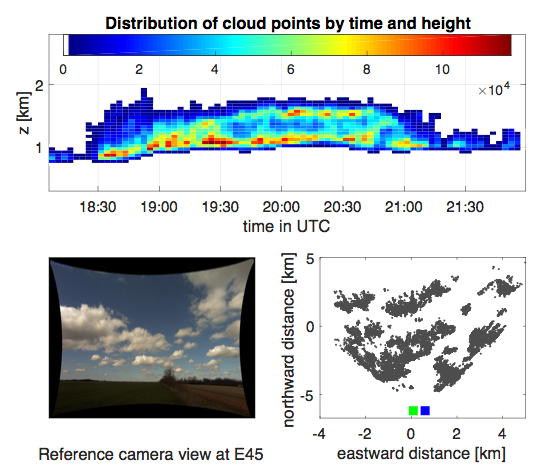Value-Added Product Delivers 3D Cloud Positions Based on Stereo Photographs
Published: 19 January 2021

A new value-added product (VAP) provides three-dimensional (3D) positions of clouds captured by stereo cameras. The Point Cloud of Cloud Points (PCCP) VAP enables 3D representations related to macrophysical cloud features such as the cloud-base and cloud-top heights, structure of cloud boundaries, and cloud-level horizontal velocities.
Currently, PCCP is available for the Atmospheric Radiation Measurement (ARM) user facility’s Southern Great Plains (SGP) atmospheric observatory in Oklahoma.
PCCP data are retrieved from images captured by stereo-calibrated camera pairs at SGP extended facilities E43 (Lamont), E44 (Billings), and E45 (Tonkawa).
The E43, E44, and E45 stereo cameras encircle the SGP Central Facility at an approximate 6-kilometer radius facing southeast, southwest, and north, respectively. Each camera has an approximate 75-degree horizontal field of view that extends out as far as tens of kilometers. Therefore, PCCP may include thousands of cloud-point positions from a wide horizontal region and altitude range at a time.
PCCP data for the three extended facilities are available with a 20-second time resolution in a netCDF format. A Python script that plots instantaneous PCCP data is also available.
The dates for available data are as follows:
- E43: September 1, 2017, to March 3, 2020
- E44: September 1, 2017, to December 1, 2019
- E45: September 1, 2017, to October 30, 2019.
Scientists can use the PCCP SGP data now, with more to come.
PCCP data are also coming from the 2018–2019 Cloud, Aerosol, and Complex Terrain Interactions (CACTI) field campaign in Argentina. In addition, there are plans for PCCP data from the upcoming TRacking Aerosol Convection interactions ExpeRiment (TRACER) in the Houston, Texas, area.
The Clouds Optically Gridded by Stereo (COGS) VAP, a four-dimensional (4D) mask of cloudiness in the common field of view of the three SGP stereo camera pairs, will be available soon.
More information about PCCP can be found on the VAP web page. For questions or to report data problems, please contact Rusen Öktem or David Romps.
Data can be referenced as doi:10.5439/1531325.
Access the data set in the ARM Data Center. (Go here to create an account to download the data.)
Keep up with the Atmospheric Observer
Updates on ARM news, events, and opportunities delivered to your inbox
ARM User Profile
ARM welcomes users from all institutions and nations. A free ARM user account is needed to access ARM data.


















